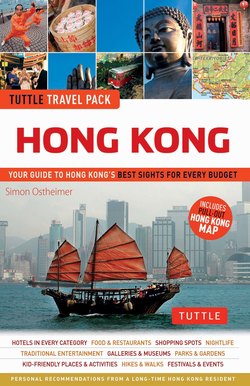Читать книгу Hong Kong Tuttle Travel Pack - Simon Ostheimer - Страница 9
На сайте Литреса книга снята с продажи.
ОглавлениеHong Kong’s STORIED PAST
As the walk-through exhibition at the Museum of History (100 Chatham Road South, 2724 9042; www.hk.history.museum) attests to the fact that Hong Kong has a long past—from prehistoric to Imperial Chinese to British, all creating the thriving modern-day metropolis we see today.
According to archaeological studies, humans have lived in the area from around 35,000 to 39,000 years ago (interestingly, they chose to first settle in Chek Lap Kok, the site of the current airport). However, it was not until the Bronze Age (3000–700 BC) that a large influx of people moved into the area, as shown by the stone carvings that still can be seen across the territory, including examples on Po Toi Island, Cheung Chau and Big Wave Bay on the south coast of Hong Kong Island. In 111 BC, what is now known as Guangdong was conquered by the forces of Emperor Wu of Han, thus establishing control of the Han Dynasty over the area. The Lei Cheng Uk Han Tomb Museum (41 Tonkin Street, Sham Shui Po, Kowloon, 2386 2863; www.lcsd.gov.hk/CE/Museum/History/en/lcuht.php) in Sham Shui Po is a burial tomb dating from the Eastern Han Dynasty (AD 25–220).
The Tang, Song and Qing Dynasties followed, as did Portuguese traders in the early 1500s, who temporarily occupied a fort in Tuen Mun. In 1699, the first British traders arrived in the form of the British East India Company. By 1711, the company had established a trading post in Canton (Guangzhou), where it continued to import its most sought-after item—opium—for the next 100 years. By 1839, Chinese addiction to the drug has become such that an Imperial Chinese commissioner named Lin Zexu appealed to Britain’s Queen Victoria to end the debilitating trade. That same year, he confiscated 1.2 million kg of opium from Western traders and threw it into the sea, an act that led directly to the First Opium War (1839–42).
After the Chinese suffered heavy defeats, they were forced to sign the Treaty of Nanking, which ceded Hong Kong Island to the British in perpetuity. The Second Opium War (1856–8) led to the ceding of the Kowloon Peninsula, then in 1898 the New Territories were occupied under a 99-year lease.
The initial growth of Hong Kong in the early 20th century was slow but steady as the British set about building a colony, introducing electricity, public transport, education and health systems as well as British-led trading, banking and financial sectors. However, a storm was brewing. On 8 December 1941, eight hours after the attack on Pearl Harbour, the Imperial Japanese army invaded Hong Kong. After a short but fierce fight, the British forces surrendered on Christmas Day. For the next 44 months of occupation, the colony suffered great hardship, and by the time liberation came in 1945, the city’s population had dropped to 600,000 from its pre-war level of 1.6 million.
However, the colony underwent a post-war boom in manufacturing, as the Civil War in China drove many Shanghai textile tycoons to set up business in Hong Kong. As the economy sped up, the ‘Made in Hong Kong’ label became known in clothing shops worldwide. Over the next few decades, the colony gradually made the shift to a service-based economy, which led to some of the highest rates for literary, life expectancy and income in the world. However, uncertainty reigned following the signing of the Sino-British Joint Declaration in 1984, which declared that the entire territory (even though Hong Kong Island and Kowloon had been ceded in perpetuity) would be returned to China on 30 June 1997, when the 99-lease for the New Territories ran out.
Despite the fact that the pact stated the principle of ‘One Country, Two Systems’, and Deng Xiaoping himself had promised 50 years of no change, many Hong Kongers, fearing the worst, emigrated to countries such as Canada, Australia and the UK. However, most misgivings have proven unfounded, as the Special Administrative Region has largely been left alone by the national government in Beijing.
While there have been wobbles, most notably during 2003, a year that saw the outbreak of SARS, and a march on 1 July against the proposed introduction of controversial anti-subversion legislation, which one in ten residents took part in, the city has continued its remarkable growth, becoming ‘Asia’s World City’, as the current government slogan goes.
